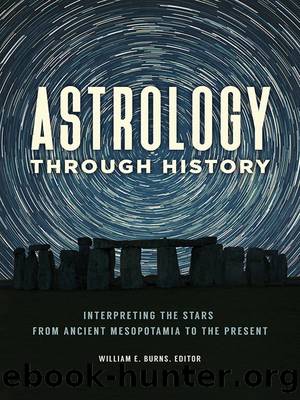Astrology Through History: Interpreting the Stars From Ancient Mesopotamia to the Present by William E. Burns

Author:William E. Burns
Language: eng
Format: epub
Publisher: ABC-CLIO
Published: 2018-06-14T16:00:00+00:00
J
JAPANESE ASTROLOGY. SEE BUDDHISM.
JOHN OF SAXONY (14TH CENTURY)
John of Saxony (also known as John Dank or John Danekow of Saxonia) was probably born in Germany and was active in astronomy 1327–1335. John of Ligneres, who wrote on mathematics, astronomy, and astronomical instruments (particularly the astrolabe) was among the most prominent Parisian astronomers of his time and his fame drew John of Saxony to Paris (where he also worked with John of Meurs).
John of Saxony’s best-known writings are his canons on the Alfonsine Tables (1327). It is difficult to overemphasize the importance of the Alfonsine Tables for medieval astronomy and astrology. The Alfonsine Tables (compiled at the request of King Alfonso X, 1221–1284, of Leon and Castile) were the first set of astronomical tables prepared in Christian Europe and permitted the calculation of eclipses and positions of the planets at any given time. They were particularly useful for plotting syzygies, the straight-line configuration of three celestial bodies in a gravitational system (such as the position of the sun, moon, and Earth during an eclipse). The tables were based on Ptolemy’s view that the Earth was at the center of the universe. They were an important source of information for Christopher Columbus (who used them as navigational aids) and Nicolaus Copernicus (before his own work on heliocentric astronomy superseded them).
Astronomers and astrologers used John’s canons to derive planetary positions (longitudes) for a given time and place. To begin, the user calculated the length of time between a base year and the year in question, divided this figure by the mean figure(s) of the planetary orbits, added or subtracted values to account for the differences in time and place (between Toledo and Paris, for example) and then noted the difference in latitude for the location in question. John’s canons were often accompanied by corresponding sexagesimal multiplication tables (a base 60 numerical system still used for measuring time and geographic coordinates).
John also wrote a commentary on Introduction to the Art of Astrology by al-Qabīī, a highly esteemed textbook on the fundamental principles of genethlialogy (the system of astrology that contends that an individual’s personality can be determined by constructing a natal chart for the date and location of that individual’s birth). John’s commentary on The Art of Astrology accompanied most Latin translations of al-Qabīī’s work until the middle of the 16th century.
Medieval manuscripts (and some modern scholars) have attributed numerous astrological and astronomical texts to John of Saxony. Many of these manuscripts are extracts of the Alfonsine Tables or other tables of eclipses; for others, authorship is suspect.
Download
This site does not store any files on its server. We only index and link to content provided by other sites. Please contact the content providers to delete copyright contents if any and email us, we'll remove relevant links or contents immediately.
Becoming Supernatural by Dr. Joe Dispenza(7099)
Tools of Titans by Timothy Ferriss(6935)
The Witchcraft of Salem Village by Shirley Jackson(6578)
Inner Engineering: A Yogi's Guide to Joy by Sadhguru(5887)
The Four Agreements by Don Miguel Ruiz(5502)
The Power of Now: A Guide to Spiritual Enlightenment by Eckhart Tolle(4749)
The Wisdom of Sundays by Oprah Winfrey(4623)
Room 212 by Kate Stewart(4099)
Fear by Osho(4083)
Pale Blue Dot by Carl Sagan(3995)
The David Icke Guide to the Global Conspiracy (and how to end it) by David Icke(3875)
Rising Strong by Brene Brown(3777)
Animal Frequency by Melissa Alvarez(3750)
How to Change Your Mind by Michael Pollan(3668)
Sigil Witchery by Laura Tempest Zakroff(3648)
Real Magic by Dean Radin PhD(3562)
Secrets of Antigravity Propulsion: Tesla, UFOs, and Classified Aerospace Technology by Ph.D. Paul A. Laviolette(3430)
The Art of Happiness by The Dalai Lama(3377)
Man and His Symbols by Carl Gustav Jung(3309)
